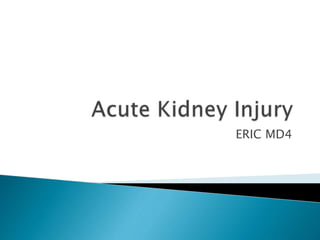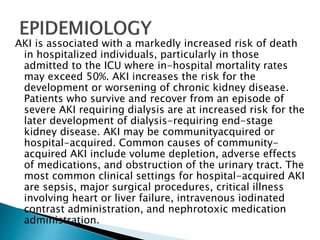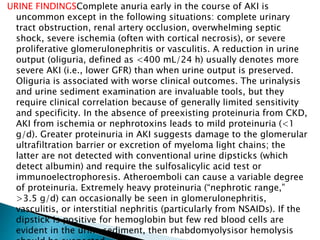AKI is characterized by a sudden impairment of kidney function resulting in the retention of waste products normally cleared by the kidneys. It is diagnosed by an increase in BUN/creatinine and/or decrease in urine output. AKI can range from asymptomatic lab abnormalities to life-threatening complications. Common causes include ischemia, nephrotoxins, sepsis, surgery, and obstruction of urine flow. A careful history, physical exam, urine analysis, and consideration of potential causes are used to diagnose the type and severity of AKI.











![Burns and Acute Pancreatitis Extensive fluid losses into the
extravascular compartments of the body frequently accompany
severe burns and acute pancreatitis. AKI is an ominous
complication of burns, affecting 25% of individuals with more than
10% total body surface area involvement. In addition to severe
hypovolemia resulting in decreased cardiac output and increased
neurohormonal activation, burns and acute pancreatitis both lead
to dysregulated inflammation and an increased risk of sepsis and
acute lung injury, all of which may facilitate the development and
progression of AKI. Diseases of the Microvasculature Leading to
Ischemia Microvascular causes of AKI include the thrombotic
microangiopathies (antiphospholipid antibody syndrome, radiation
nephritis, malignant nephrosclerosis, and thrombotic
thrombocytopenic purpura/hemolytic-uremic syndrome [TTP-
HUS]), scleroderma, and atheroembolic disease. Large-vessel
diseases associated with AKI include renal artery dissection,
thromboembolism, thrombosis, and renal vein compression or
thrombosis.](https://image.slidesharecdn.com/akickd-200530184118/85/Aki-amp-ckd-12-320.jpg)




























![It is important to identify factors that increase the risk for CKD, even in
individuals with normal GFR. Risk factors include small for gestation
birth weight, childhood obesity, hypertension, diabetes mellitus,
autoimmune disease, advanced age, African ancestry, a family history of
kidney disease, a previous episode of acute kidney injury, and the
presence of proteinuria, abnormal urinary sediment, or structural
abnormalities of the urinary tract. Many rare inherited forms of CKD
follow a Mendelian inheritance pattern, often as part of a systemic
syndrome, with the most common in this category being autosomal
dominant polycystic kidney disease. To stage CKD, it is necessary to
estimate the GFR rather than relying on serum creatinine
concentrationMany laboratories now report an estimated GFR, or eGFR,
using one of these equations. The normal annual mean decline in GFR
with age from the peak GFR (~120 mL/min per 1.73 m2) attained during
the third decade of life is ~1 mL/min per year per 1.73 m2, reaching a
mean value of 70 mL/min per 1.73 m2 at age 70. Although reduced GFR
occurs with human aging, the lower GFR signifies a true loss of kidney
function, with all of the implications that apply to the corresponding
stage of CKDThe mean GFR is lower in women than in men. For example,
a woman in her 80s with a normal serum creatinine may have a GFR of
just 50 mL/min per 1.73 m2. Thus, even a mild elevation in serum
creatinine concentration (e.g., 130 μmol/L [1.5 mg/dL]) often signifies a
substantial reduction in GFR in most individuals.](https://image.slidesharecdn.com/akickd-200530184118/85/Aki-amp-ckd-41-320.jpg)




























![Treatments aimed at specific causes of CKD are discussed elsewhere.
Among others, these include optimized glucose control in diabetes
mellitus, immunosuppressive agents for glomerulonephritis, and
emerging specific therapies to retard cystogenesis in polycystic
kidney disease. The optimal timing of both specific and nonspecific
therapy is usually well before there has been a measurable decline
in GFR and certainly before CKD is established. It is helpful to
measure
sequentially and plot the rate of decline of GFR in all patients.
Any acceleration in the rate of decline should prompt a search for
superimposed acute or subacute processes that may be reversible.
These include ECFV depletion, uncontrolled hypertension, urinary
tract infection, new obstructive uropathy, exposure to nephrotoxic
agents (such as nonsteroidal anti-inflammatory drugs [NSAIDs] or
radiographic dye), and reactivation or flare of the original disease,
such as lupus or vasculitis.](https://image.slidesharecdn.com/akickd-200530184118/85/Aki-amp-ckd-70-320.jpg)



